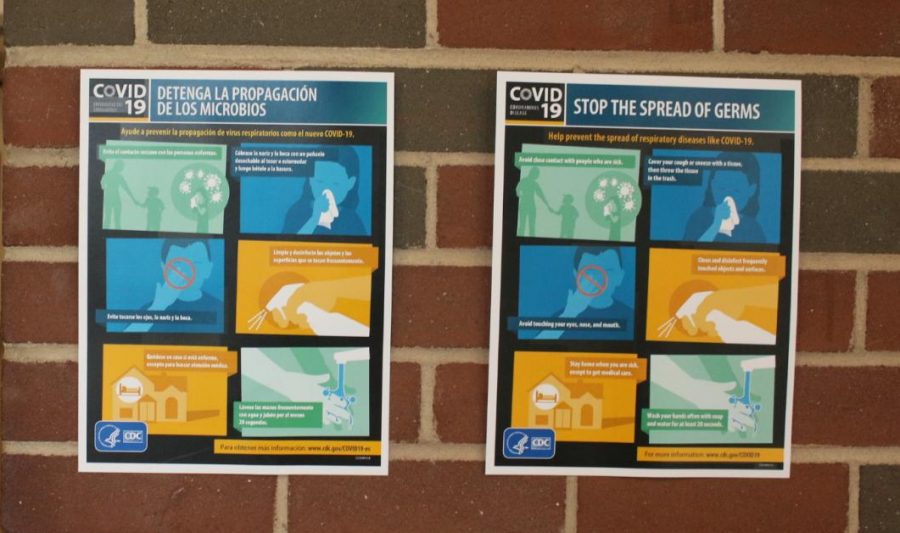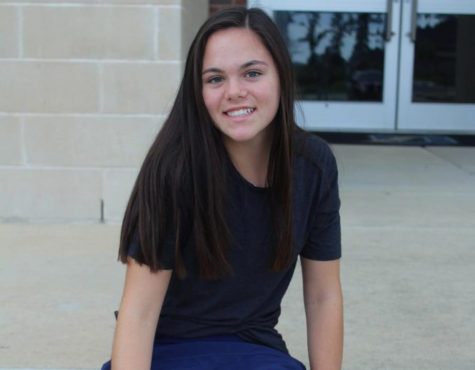OSD combats COVID-19 with numerous safety measures
Posters in Spanish and English from the Centers of Disease Control and Prevention (CDC) remind students to practice safe hygiene. Posters similar to these can be seen all around the school.
November 5, 2020
After going entirely online for the fourth quarter of the 2019-2020 school year, OSD decided to give students a choice between remaining virtual or returning to school in person this fall. Students who chose face-to-face instruction follow a variety of guidelines in order to protect themselves from COVID-19. Each day, students have their temperatures checked before walking into their first period classes. Between periods, desks are cleaned with disinfectants. All hallways have one-way traffic to minimize the spread during class changes. Students are required to wear masks inside the building and they must socially distance when they can. According to OHS Principal Noah Hamilton, the district took the process of coming up with these specific safety measures very seriously.
“Mr. Harvey [the OSD Superintendent] put together a district-level committee made up of all the principals at each of the schools, and then some of the operations people, and we took all of the CDC guidelines and tried to put them into the context of a school setting,” Hamilton said. “Mr. Harvey even had an outside committee that he put together made up of some doctors, businesspeople and some university folks, and they did a walkthrough here at the school of what [the rules] would look like in a classroom. [We asked questions like] can we socially distance? How many can we get into a room and still socially distance? What does a bus ride look like? What does it look like in the cafeteria? So [we] did all those things and then we put all that together and came up with our ‘return to learn’ plan.”
While students are encouraged to socially distance when they can, Hamilton realizes that this is not always possible considering the different sizes of the classrooms. “We’ve got some classes where six feet just is not realistic. There’s too many students in the classroom,” Hamilton said. “So what teachers are doing is, they’re making the distance as much as they can, just to try to help mitigate and ease some of those risks. Some of those classes can have six feet, especially with some students not being on campus, so that has lowered some numbers, but we still have some classes that are going to have 25 or 26 students and it’s just very difficult to have six feet [of distance] with 25 kids in a classroom.”
However, even when social distancing is not possible, students must wear masks at all times while in the school building. For Hamilton, he was pleasantly surprised with the students’ acceptance of the rules.
“Honestly, students here at the school have done a great job of following those guidelines and doing those things,” Hamilton said. “For the most part, we have not had to get onto kids about not wearing [their masks.] We haven’t had to get onto people about using the one way hallways, they’ve done all those things that we asked. I think realistically, everybody has stepped up and done what has needed to be done.”
On the first day of school, 34 percent of the OHS student body attended school online. After two weeks, that number had dropped to 28 percent. Hamilton believes that the decrease is due to some virtual students feeling safe enough to return to school because of the student body’s ability to follow the new safety guidelines.
“I have a lot of friends in administration throughout the state and in some other states, and they’re not having the same success as we are,” Hamilton said. “Our students have taken this situation that could have been an absolute disaster, and made it much better than it ever could have been. It could have been an absolute disaster with students here, but because I think they want to be here, they’re doing whatever they have to do to make sure that we stay here and to give our [virtual] students that opportunity to come back sooner perhaps. I think that’s how the majority of our [in person] students see it: it’s about everybody, and not just themselves.”
A large number of virtual students chose to learn remotely because they wanted to keep family members with underlying health conditions safe. However, for many students, learning online makes it much more difficult to stay motivated. Students who were able to come back in person were thankful that they had the option to return to school.
“I felt like [face-to-face instruction] would be a better learning experience. I was scared that I would fall behind in my classes if I went online,” sophomore Claire Anne Boudreaux said. “I just had trouble finding motivation when we went online [last year.]”
According to Boudreaux, the COVID-19 rules are flexible enough for students to feel comfortable in their classes.
“I feel like there’s enough freedom where students can sit distanced if they need to, and teachers are understanding about that, and if people do wear their masks, I know that that greatly reduces the risk of exposure,” Boudreaux said.
For Hamilton, the pandemic provides a great opportunity to show students that life can sometimes take an unexpected turn.
“You can make excuses for everything that’s going down the road right now, but that’s not happening,” Hamilton said. “We’re seeing more and more of our students that are taking control of the situation, and if they have to be a virtual student, they are working very hard to be the best virtual students that they can be. We’ve got students that maybe haven’t been the best students academically in the past, but are working so hard right now to be the best student they can be. As you become adults, you will discover that there are a lot of people and situations that will try to define who you are, and the worse thing you can do as a human is to allow other things to define who you are as a person.”





